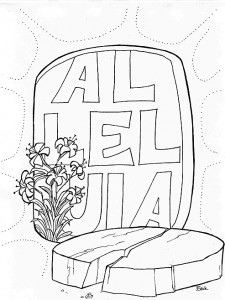John’s vision of the Son of Man
April 3, 2016
SECOND SUNDAY OF EASTER
(SUNDAY OF DIVINE MERCY)
Acts 5:12-16
Life of the early community
Ps 118:2-4, 13-15, 22-24
His Mercy endures forever
Rev 1:9-11a, 12-13, 17-19
John’s vision of the Son of Man
Jn 20:19-31
Thomas in the upper room
http://www.usccb.org/bible/readings/ 040316.cfm
During the Easter season, the lectionary departs from the usual program. For the first reading, passages from Acts of the Apostles replace the Old Testament readings we usually hear. Typically, we begin the Easter season with accounts of the early community in Acts. That is true this year as well, with the emphasis today being on the healing taking place in the Temple area when the Christians gathered there.
Meanwhile, the choice for the second reading differs from year to year, according to the cycle. This year we feature the book of Revelation. The reading is from the introductory part of that book. We meet the author, and hear the call for him to write the book that we are about to read. The vision it gives of the Son of Man is heavily symbolic, with language taken from different parts of the Old Testament. The reading for the day is somewhat selective, presenting the main thought, without the more curious elaborations. However, for those who are interested enough to check in their Bible, note the footnotes. Cross-references to the prophetic writings abound, and the passages they indicate make their own contributions.
[ms-protect-content]
 The Gospel readings for the Easter season are taken from John’s Gospel, which doesn’t have a liturgical season of its own. The selection for today, the Second Sunday of Easter, is always the same, and for a good reason. This is the only place we have mention of an appearance of the risen Christ said to occur specifically on the week after Easter. Of course, it also includes the appearance on Easter Day, since that sets up the story about Thomas a week later. Yet we can assume that the thrust of the passage is the part about Thomas.
The Gospel readings for the Easter season are taken from John’s Gospel, which doesn’t have a liturgical season of its own. The selection for today, the Second Sunday of Easter, is always the same, and for a good reason. This is the only place we have mention of an appearance of the risen Christ said to occur specifically on the week after Easter. Of course, it also includes the appearance on Easter Day, since that sets up the story about Thomas a week later. Yet we can assume that the thrust of the passage is the part about Thomas.
This is not the only time John’s Gospel repeats a scene. It is a feature of John’s storytelling style. Other examples include John the Baptist’s announcement, “Behold, the Lamb of God.” This introduces two similar scenes (1:29,36). Then there is the meeting with Lazarus’s sisters, Martha and Mary, each scene beginning with the same statement: “Lord, if you had been here, our brother would not have died” (11:21, 32). Note also the account of Jesus’ arrest in Gethsemane, again repeated, each time beginning with the question, “Who are you looking for?” (18:4, 7). We see this to be a favorite technique of John.
How are we to read these twice-told passages? John seems to be inviting us to compare the two versions. It allows us to look at one side and then another. After Martha meets Jesus, they talk of the Resurrection and the Life. But after her sister Mary greets him, he grieves. Both sides of the experience of Christian death are given their moment.
In the present case of the Easter encounters with the risen Christ, we again have a repeated line setting up the comparison: “Jesus came and stood in their midst and said to them, ‘Peace to you’” (20:19, 26). (It is actually more complex than this, insofar as the instance on Easter Day is itself repeated (20:19, 21). But that’s another story.)
So what are we to make of it? What does the second add to the first? Most obviously, it focuses on the witness to resurrection. With Thomas, we have the additional witness of a skeptic. Some might think that the apostles were gullible, that they succumbed to a desire for something more than the ending that they had just experienced in the Passion and Death of Jesus. But the Thomas story answers this suspicion. Thomas is not easily fooled. His word has the value of greater credibility. He is the ultimate witness.
For reflection: Why is Easter witness so central to the Gospels?
Father Beck is professor emeritus of religious studies at Loras College, Dubuque.
[/ms-protect-content]



